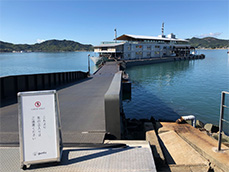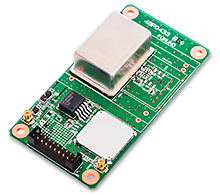Articles for ITS market Tsuneishi Shipbuilding's building and DX, an exclusive visit to the main factory
Tsuneishi Shipbuilding attracts attention from various industries
Tsuneishi Shipbuilding is attracting a lot of attention from various industries.
Tsuneishi Shipbuilding Co., Ltd. was established in 1917 in Tsuneishi, Numakuma-cho, Fukuyama City, Hiroshima Prefecture, Japan in the Seto Inland Sea, and is the core company of the Tsuneishi Group, whose main business is shipbuilding and shipping.
There are a number of reasons why the company has attracted a lot of attention from various industries.
The most recent and most significant impact has been the signing of a capital alliance with Mitsui E&S Shipbuilding (Merchant shipping business), announced on October 1st, 2021.
Mitsui E&S Shipbuilding is one of Japan’s leading shipbuilding giants, having its origins in the former Mitsui Shipbuilding & Engineering's Ship & Naval Business Division.
Since May 2018, Tsuneishi Shipbuilding and Mitsui E&S Shipbuilding have been discussing joint research and development, mutual cooperation in parts procurement activities and personnel exchange in the field of merchant shipbuilding.
In recent years, the Japanese shipbuilding industry has seen a growing number of partnerships, joint ventures and acquisitions. Both in Japan and overseas, as the industry focuses on strengthening its competitiveness in terms of manufacturing costs with foreign companies such as China.
Through this capital tie-up with Mitsui E&S Shipbuilding, Tsuneishi Shipbuilding is expected to make great strides in the field of advanced technologies, such as automatic ship operation.
In terms of carbon neutrality, on September 30th, 2021, an official announcement was made by related companies, including Tsuneishi Shipbuilding, about ships that will be equipped with electric power units.
According to the announcement, Tsuneishi Shipbuilding, in collaboration with Nippon Steel Corporation, NS United Coastal Shipping, Kawasaki Heavy Industries and others, will build a hybrid coastal coal carrier that will utilize a natural gas engine.
The hybrid vessel will measure approximately 93.8m in length, 19.2m in width and 9.9m in depth, with a deadweight capacity of approximately 5,560-ton, and is scheduled to enter service in February 2024 from the port of Shiriyamisaki on the Shimokita Peninsula in Aomori Prefecture to the port of Muroran in Hokkaido.
The author visited Tsuneishi's main factory, the heart of the company, on his own.
 KAMSARMAX undergoes the final manufacturing process at the shipyard. Photo by the author.
KAMSARMAX undergoes the final manufacturing process at the shipyard. Photo by the author.
 KAMSARMAX’s propeller and rudder, designed by Tsuneishi Shipbuilding. Photographed by the author.
KAMSARMAX’s propeller and rudder, designed by Tsuneishi Shipbuilding. Photographed by the author.
 A large module is lifted by crane and moved by a large cart. Photographed by the author.
A large module is lifted by crane and moved by a large cart. Photographed by the author.
 Large welded modules are lined up. Photographed by the author.
Large welded modules are lined up. Photographed by the author.
Shipbuilding of bulk carriers. What I saw and heard at the site
In the second half of October 2021, I left JR Fukuyama Station for the Seto coast by a rental car.
The first stop was Tomonoura, known as the model for Hayao Miyazaki's Studio Ghibli film "Ponyo on the Cliff by the Sea".
From there, we headed further west along the Numakuma Peninsula, where the road entered a mountainous area, and further on, a shipbuilding area with huge cranes suddenly appeared.
This is Tsuneishi.
Tsuneishi Shipbuilding's head office and factory covers an area of about 500,000 square meters including the surrounding area. It is slightly larger than Tokyo Disney Sea, or about 10 times the size of Tokyo Dome.
We were welcomed by Mr. Takuma Ashida, Exclusive Managing Director of Tsuneishi Shipbuilding Co. Mr. Ashida is the Factory Manager of Tsuneishi Shipyard and is in charge of the factories in China and Philippines. Everyone from various departments joined us for this site visit and an exchange of opinions.
The first thing we saw during our tour of the factory was the ship's berth.
This is the facility where the hull, the main body of the ship, is finally assembled and the completed ship is launched.
At the time of the visit, shipbuilding was being carried out on Tsuneishi's flagship product, the 82,000-ton KAMSARMAX bulk carrier.
The name KAMSARMAX comes from the fact it is the largest size vessel that can pass through the Panama Canal and enter the port of Kamsa in Guinea. It is the global standard for bulk carriers and the best seller in the shipbuilding industry, with some 340 ships having been built here since 2003. The whole shipbuilding process takes 10 to 11 months. Tsuneishi shipbuilding designs the propellers which are propelled by the engine power, and the rudder which controls the ship.
Next, we visited the internal factory (Dock).
The flow of work in the factory is as follows: first steel sheets delivered from steel manufacturers to NC shearing machine to produce materials for parts; and then large press machines to press and bend parts; and finally welding parts and painting processes in a separate building.
In some parts of the bending process, the workers still heat and deform the parts by hand, so that the craftsmanship is still preserved.
Each bulk carrier, such as KAMSARMAX, consists of about 300,000 parts, of which about 100,000 are steel plate related parts.
The structure of a merchant vessel, such as a bulk carrier, is made up of three main elements: the hull which is the main body of the ship; the engine and machinery plant; and the accommodation area where the people involved in the operation of the ship stay.
The hull is manufactured in about 80 modules, which will be raised and assembled by a crane. Some modules are sent to Tsuneishi Shipbuilding's overseas factories to be assembled and then returned back to Tsuneishi Shipbuilding's main factory.
Tsuneishi Shipbuilding currently manufactures about 50 vessels a year at its three factories in Japan, China and the Philippines, with Japan accounting for less than 20% of the total, and the rest being manufactured overseas in view of the production costs.
Tsuneishi Shipbuilding’s DX. Current and future shipbuilding business
Many people may think that merchant vessels, such as bulk carriers do not undergo frequent model changes like cars do.
In fact, however, even bulk carriers undergo a full model change at a relatively fast rate of once every four or five years.
The reason for this is the constant requirement and update requests from customers.
In recent years, the competition of fuel efficiency has become more demanding, but in terms of development and design, a system for numerical calculation of fluids has been established. And the speed of development has increased, making it easier to change models.
Tsuneishi Shipbuilding is promoting DX (Digital Transformation) not only in such basic design requirements but also in the area of overall management from design to manufacturing.
Exclusive Managing Director Mr. Ashida says, "The effects of DX are definitely appearing." And the company is determined to make effective use of DX within the company to further strengthen its cost competitiveness, and to develop new technologies such as automatic ship operation and hybrid ships.
One of the things that surprised me during my visit was the fact that the price of a new ship is the market value at the time of the sale contract. Moreover, the range of price fluctuations is quite large.
As the global market is moving from "with Corona" to "after Corona", I realized that the key to success in the shipbuilding business is to grasp the changes in supply and demand in the ship market in a timely manner. In addition to the sharp rise in material prices.
We will continue to cover shipbuilding and other ship-related areas on a regular basis.
Writer introduction

Mr. Kenji Momota Automotive journalist
His major is the world automotive industry and he is also familiar with the energy industry, IT and the aging society problem as the related fields. He acts around the world based in Japan and USA and writes for the general magazines, the technology journals and the automotive related media etc.
He is also commentator of motor race and world's motor show on TV program based on his career of the driver of Indy Racing League and NASCAR. In recent years, he has been covering about a paradigm shift from developed countries to developing countries, the motorized vehicle like EV and the telematics.
FURUNO ITS Journal
Click here for the latest articles after 2022 (in Japanese)2022
- The "realistic" self-driving roadmap shown by the Japanese government and a hands-on report on the latest Subaru EyeSight X
- Will FCVs (Fuel Cell Vehicles) Become Popular? ~New Movement in Toyota and Honda~
- The 'Complete' online sales of new cars start in Japan. Will this new way of buying cars take root?
- Many Firsts! On-Site Report from Tokyo Auto Salon 2022 - The author, who knows what goes on behind the scenes, looks back on 40 years of history. -
2021
- "Moving toward zero traffic fatalities for four-wheeled and two-wheeled vehicles globally in 2050" ~Experience on Honda's latest safety technologies~
- Tsuneishi Shipbuilding's building and DX, an exclusive visit to the main factory
- Japan's Smart City: New Moves toward Practical Use
- When will self-driving buses (service cars) be put to "full-scale" practical use?
- Utilization vehicle data during disasters
- Toyota-led Connected Technology to Transform Commercial Vehicle Business -From light trucks to large trucks and buses-
- Toyota enters the connected car "Personalization" business
- Japanese automakers' carbon-neutral strategies swept up in ESG investment
- Drive experience of the latest autonomous vehicle models and advanced driving support systems
- Will carbon neutrality accelerate the trend to strengthen LCA (Life Cycle Assessment)?
- Semiconductor shortage exposes realities of the automotive industry
- Online Autonomous Driving Contest Enhancing development of Human Resources
2020
- What happens to CASE when gas cars are banned in Japan?
- When will Flying Cars be launched?
- Expectation vs. reality:Autonomous Driving in Japan
- V2X, Becoming increasingly important in autonomous driving
- Technology of Subaru “EyeSight X”
- Lifestyle-oriented French cars gain popularity in Japan
- Human-oriented smart cities are wanted
- MaaS and CASE, how would automotive industry change after COVID-19?
- The beginning of virtualization era, triggered by COVID-19
- Trend of EV shift and consumer demands
- TOYOTA Press conference about ADAS - Releasing algorithm for "sudden acceleration suppression during attempted sudden acceleration" free of charge -
- The Japanese automotive industry in 2020 - 3 turning points -
- "Using a smartphone while driving" and "Level 3 automated driving"
2019
- Motor show business model is at a turning point - Tokyo Motor Show Report -
- Commercialization and monetization of MaaS - ITS World Congress Singapore Report -
- Android Automotive pays attention to V2X - Report from the Frankfurt Motor Show 2019 in Germany -
- Automobile Distribution Revolution and DCM (Data Communication Module)
- Connected business potential and newly proposed "eMaaS" by Honda
- 5G services for practical use are multiplying
- Connectivity technologies attracting attention due to frequent traffic accidents
- Shanghai Motor Show report -SUV, EV, Automated car & 5G-
- Drone Business roadmap and updates to Michibiki (Quasi-Zenith Satellite System)
- MaaS (Mobility as a Service) "town development." Full-scale promotion for a national project
- CES organizer states "Data Period in 2020s." Transformation of the Automotive Industry in CES, US "-CES2019 Report-"
- "Return to Origin" directed towards the age of change, automatic operation and connectivity
2018
- New proposal for Private Car Automated Driving Level and other Hot 5G Technology Topics
- Standardized EV charging infrastructure concerns in Europe, US, Japan and China - Kobe EVS 31 field report -
- Touring a pure car carrier and a test drive of the latest hybrid car
- Planning stage products are exhibited at the newly established visualized mobility service "TOYOTA MOBILITY SHOWROOM".
- Potential “Community Car-share” program promoted by local residents
- CES Asia Report 2108
- Companies attempt new Vehicle-to-Infrastructure communications, including traffic volume measurements and vehicle positioning. -ITS Asia Pacific Forum in Fukuoka-
- Geneva show in Switzerland. Flying cars and MaaS (Mobility as a Service) were hot topics.
- EV (Electric Vehicle) proposals by country
- MaaS competition through service mobilization, M & A and technical field collaboration is accelerating. - The CES 2018 Report -
2017
- Big data’s initiative and fight for the automotive industry. Cooperation among companies becomes increasingly important.
- Connected car and road-to-vehicle communication automatic operation
- ETC (Electronic Toll Collection) and ETC2.0. Current situation and projected future
- Rapid development of sharing economy
- Germany is first to recognize level 3 automated driving
- ITS EU 2017 Field Reports -Automatic Operation and the eCall-
- From Infotainment to ITS, the competitive area is spreading in the car big data industry.
- GTC (GPU Technology Conference) Report and the de facto standardization of AI (artificial intelligence)
- Renesas' new challenge! "e-AI Solution" and "Renesas Autonomy"
- The Automobile industry is shifting from a manufacturing industry to a service industry.
- The movement toward accident countermeasures for aging drivers in Japan
- Fusion of ride sharing and fully automated driving is advancing in the USA.
2016
- Overview of the Quasi-Zenith Satellite System (QZSS) and advancements toward full-scale practical use including the Tokyo Olympic Games - G-space EXPO 2016 report-
- Japan’s automated driving project "SIP-adus" will be a large demonstration experiment.
- The International Home Care & Rehabilitation Exhibition. There were many car manufactures with exhibits booths at this show.
- Japanese car manufacturers starting to concentrate on strengthening the ADAS system
- A new movement of legislation for autonomous cars
- Cyber Security and “AGL”, the new OS for automotive are hot topics in the connected car industry
- “High precision 3D map” the key future of autonomous car and pedestrian dead reckoning
- Chinese “BAT” is accelerating their business in the EV (Electric Vehicle) market
- Tesla's original connection to Taiwan and the new transportation system technologies.
- "The main topic" of the Geneva Motor Show was how to strengthen "pedestrian protection"
- The probe data business is getting more competitive
- Reporting directly from the 2016 CES show "Data services will soon become the main revenue source of automotive industry"
2015
- Do the automated driving systems need the GNSS (Global Navigation Satellite System) ?
- ETC Version 2.0 is coming soon. A new service was announced at the Tokyo Motor Show and the possibility that is could be used as a device for older drivers.
- "Connected Horizon" and "eHorizon". Germany's leading parts supplier accelerates strengthening of "Big Data" for business



 The entrance to Tsuneishi's main factory. Photographed by the author.
The entrance to Tsuneishi's main factory. Photographed by the author. View of Tsuneishi's main factory in Fukuyama City, Hiroshima Prefecture, from Bella Vista Spa & Marina Onomichi in Onomichi City, an affiliate of Tsuneishi Group and adjacent to the main factory. Photographed by the author.
View of Tsuneishi's main factory in Fukuyama City, Hiroshima Prefecture, from Bella Vista Spa & Marina Onomichi in Onomichi City, an affiliate of Tsuneishi Group and adjacent to the main factory. Photographed by the author. Panoramic view of the factory, where steel plates are sheared and welded. Photographed by the author.
Panoramic view of the factory, where steel plates are sheared and welded. Photographed by the author. Tsuneishi's 3,200-ton passenger ship "guntû" in the marina of Bella Vista Spa & Marina Onomichi. Photographed by the author.
Tsuneishi's 3,200-ton passenger ship "guntû" in the marina of Bella Vista Spa & Marina Onomichi. Photographed by the author. GPS/GNSS Receiver&Chips and Modules (positioning and timing)
GPS/GNSS Receiver&Chips and Modules (positioning and timing)